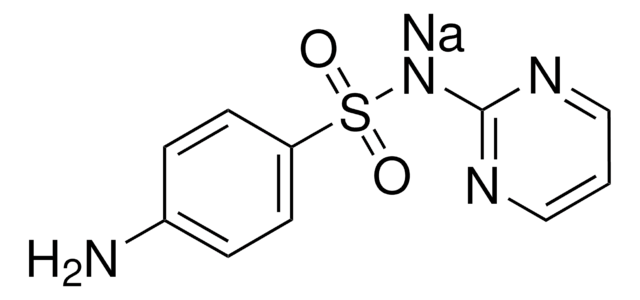237213
Sodium nitrite
ACS reagent, ≥97.0%
About This Item
Produits recommandés
Qualité
ACS reagent
Niveau de qualité
Agence
suitable for EPA 300
Pureté
≥97.0%
Forme
powder or crystals
Température d'inflammation spontanée
914 °F
Impuretés
≤0.01% insolubles
Pf
271 °C (lit.)
Traces d'anions
chloride (Cl-): ≤0.005%
sulfate (SO42-): ≤0.01%
Traces de cations
Ca: ≤0.01%
Fe: ≤0.001%
K: ≤0.005%
heavy metals (as Pb): ≤0.001%
Chaîne SMILES
[Na+].[O-]N=O
InChI
1S/HNO2.Na/c2-1-3;/h(H,2,3);/q;+1/p-1
Clé InChI
LPXPTNMVRIOKMN-UHFFFAOYSA-M
Vous recherchez des produits similaires ? Visite Guide de comparaison des produits
Catégories apparentées
Description générale
Application
Solvent free aerobic oxidation of alcohols with 1-methyl-2-azaadamantane N-oxyl as a recyclable catalyst through phase separation
- The Sandmeyer reaction for converting amines into diazo derivatives, and nitration reaction.
- The oxidative C-C bond formation reaction in the presence of oxygen as the terminal oxidant.
- The oxidative carbonitration of alkenes in the presence of K2S2O8.
It can also be used as a nitrating agent in organic synthesis. For example, NaNO2 is used in direct C-H nitration, ipso-nitration, and nitration via transition metal-catalyzed cross-coupling reaction.
Mention d'avertissement
Danger
Mentions de danger
Conseils de prudence
Classification des risques
Acute Tox. 3 Oral - Aquatic Acute 1 - Eye Irrit. 2 - Ox. Sol. 3
Code de la classe de stockage
5.1B - Oxidizing hazardous materials
Classe de danger pour l'eau (WGK)
WGK 3
Point d'éclair (°F)
Not applicable
Point d'éclair (°C)
Not applicable
Certificats d'analyse (COA)
Recherchez un Certificats d'analyse (COA) en saisissant le numéro de lot du produit. Les numéros de lot figurent sur l'étiquette du produit après les mots "Lot" ou "Batch".
Déjà en possession de ce produit ?
Retrouvez la documentation relative aux produits que vous avez récemment achetés dans la Bibliothèque de documents.
Les clients ont également consulté
Contenu apparenté
This page is intended to make it easier to find the consumables you need based on the analytical method you’re using. Methods included on this page come from the EPA, Standard Methods and ASTM.
This page is intended to make it easier to find the consumables you need based on the analytical method you’re using. Methods included on this page come from the EPA, Standard Methods and ASTM.
This page is intended to make it easier to find the consumables you need based on the analytical method you’re using. Methods included on this page come from the EPA, Standard Methods and ASTM.
This page is intended to make it easier to find the consumables you need based on the analytical method you’re using. Methods included on this page come from the EPA, Standard Methods and ASTM.
Notre équipe de scientifiques dispose d'une expérience dans tous les secteurs de la recherche, notamment en sciences de la vie, science des matériaux, synthèse chimique, chromatographie, analyse et dans de nombreux autres domaines..
Contacter notre Service technique










